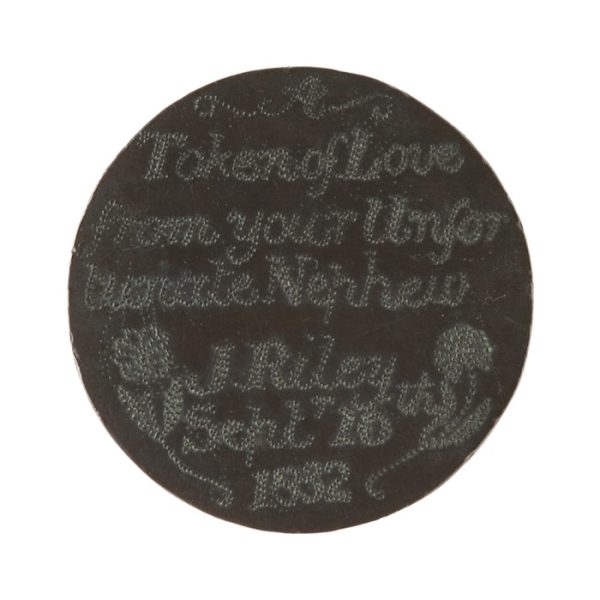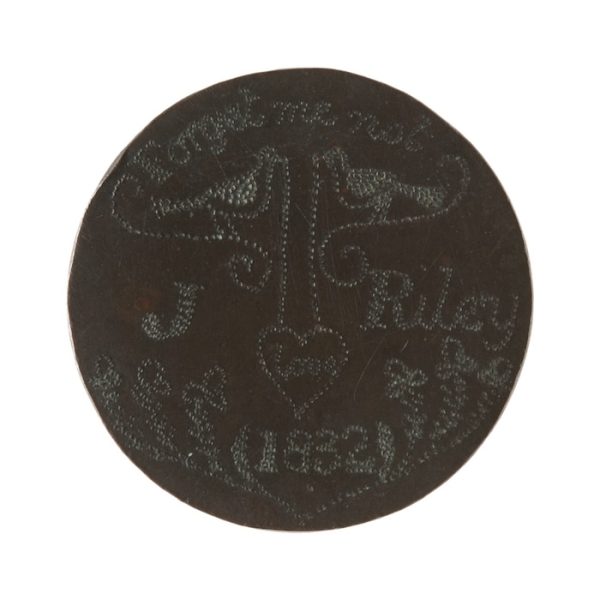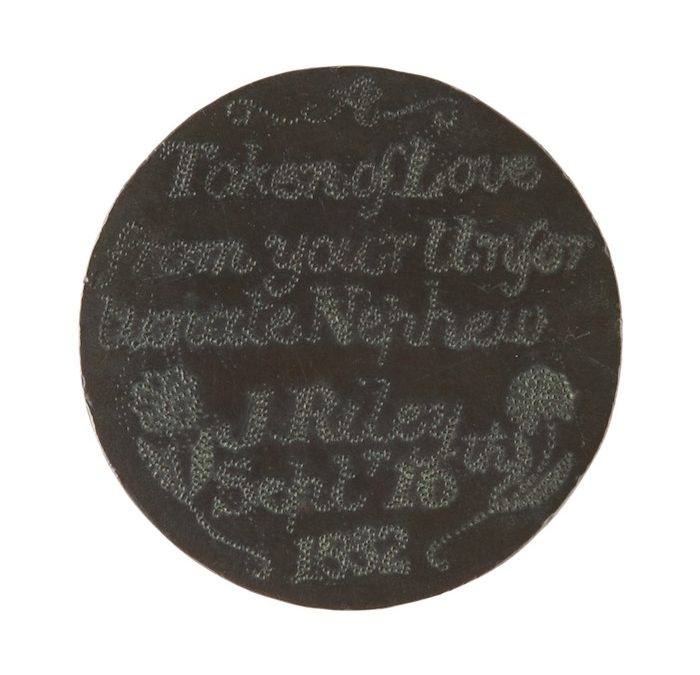Written by RAHS Volunteer and Copywriter, Christina King
This blog post is part of a series entitled ‘The Convict Experience: Love, Life and Liberty Beyond the Chains’. Each month we will explore a different – and often rather unusual – type of primary evidence historians can use to hear convict voices telling their own stories.
Movingly known as ‘leaden hearts’[1] and ‘likened to portable graffiti’[2], convict love tokens have been described as ‘a unique chance to see the convicts as they saw themselves, with their hearts on their sleeves’[3].
Happily for historians, they are another earpiece for listening to the convicts recounting their own experiences of conviction, transportation, love and loss.

Figure 1 – Obverse inscription: ‘A Token of Love from your Unfortunate Nephew J.Riley Septr 16th1832’. Convict Love Tokens API. [Image Courtesy: Katie Green, National Museum of Australia, accessed 12 May 2019, http://love-tokens.nma.gov.au/tags/hearts/2008.0039.0133]
A love token was, essentially, a coin which had been smoothed down. To this flattened surface was added a message, often accompanied by an image, either through engraving or stippling—markings made using tiny pin pricks.
Commonly used coins included pennies, halfpennies, twopence and sixpence[4].
Made in England, the tokens were sent or given to loved ones by a prisoner upon their conviction prior to their transportation as a means to keep their own memory alive after their departure.
It seems in fact that many of the tokens were produced from inside the actual prisons themselves or even from the hulks (decommissioned war ships repurposed into temporary floating prisons) whilst inmates awaited transportation. In his 1877 book The Chronicles of Newgate, Sir Arthur Griffiths describes the process almost as a way to pass the time: ‘The more peaceably disposed found some occupation in making Newgate tokens, leaden hearts…’[5].
The manufacturers of the tokens were not necessarily all professional craftsmen, although some of the keepsakes certainly demonstrate a level of professional skill. Amateurs would have made others, evident through the less accomplished techniques used[6].
Either way, tokens would include some or all of the following: the convict’s name, the name of their loved one, the length of their sentence, and a common phrase or expression relating to the two being separated[7]. A particularly common but no less poignant phrase engraved on many love tokens was, ‘When this you see, remember me’.
A date was sometimes included in the inscription too, as was the prisoner’s crime and an engraved image; common motifs comprised love hearts, “jail birds” and sailing ships.
As historical evidence with such a level of detail recorded on them, these love tokens unquestionably allow one small aspect of the convict experience to speak for itself, ‘entreating the recipient to keep alive the memory of the giver.’[8]
But what of the individual convict voices and stories? In order to hear these, specific examples of these keepsakes must be examined.

Figure 2 – Reverse inscription: ‘Forget me not J. Riley 1832’. Convict Love Tokens API. [Image Courtesy: Katie Green, National Museum of Australia, accessed 12 May 2019, http://love-tokens.nma.gov.au/tags/hearts/2008.0039.0133]
One example of a love token commissioned by Thomas Tilley, transported on the First Fleet, describes a crime of fraud rather than his actual crime, which was theft with force. His fraud is described on the love token as simply ‘signing a note’[9].
Certainly, love tokens were a way for the transported convicts to be remembered; sometimes though, it seems they wanted to be remembered in a better light than their crime may have allowed as in Tilley’s case.
The reverse of Tilley’s token shows an image of a bird, chained by the neck to the ground. An affecting picture of a “jail bird”—and perhaps also of how Tilley felt about his own situation. His token records him being sent to the hulks on 24 January 1786 but he was not transported to Botany Bay until some time in 1787 [10]; at least twelve months spent in the squalid conditions of the hulks would surely have reinforced his sense of imprisonment.
Notably, these ‘leaden hearts’ were not always made and intended for a romantic lover. Some were sent by a prisoner to a family member to ensure his or her memory remained alive amongst kin. For instance, Figure 1 shows the front of a token from 1832 inscribed with the message ‘A Token of Love from your Unfortunate Nephew J. Riley’. The reverse of the same coin (Figure 2) implores its owner, ‘Forget me not J. Riley 1832’.
Paul Donnelly describes these love tokens as ‘evoking desperate sentiment’ but also as objects which suggest ‘the desire to remember, and the need to be remembered.’[11]
Certainly, there is a degree of desperation in the messages left on the coins. But there is also an irrefutable desire inherent in these historical objects to not be forgotten, and to ensure that their voices were heard years—perhaps many, many years—later.
References:
[1] National Museum of Australia, Convict Love Tokens, http://love-tokens.nma.gov.au/, accessed 7 May 2019.
[2] Paul Donnelly, ‘“A bracelet of bright haire”: Memory and tokens of love’, in Michele Field & Timothy Millett (eds.), in Convict Love Tokens: The leaden hearts the convicts left behind, Kent Town: Wakefield Press, 1998, p.58.
[3] Michele Field, ‘Introduction’, in Convict Love Tokens, p.1.
[4] Rebecca Nason, ‘A little piece of my heart…The Convict Love Token collection of the National Museum of Australia’, Journal of the Numismatic Association of Australia20, 2009, p.36.
[5] Sir Arthur Griffiths, “The Chronicles of Newgate” (1877) quoted in Timothy Millet, ‘Leaden hearts’, in Convict Love Tokens,p.9.
[6] Millet, ‘Leaden hearts’, pp.17-20.
[7] NMA, Convict Love Tokens, http://love-tokens.nma.gov.au/.
[8] Nason, ‘A little piece of my heart’, p.36.
[9] Museum of Applied Arts and Sciences, Convict love token engraved by Thomas Tilley. https://collection.maas.museum/object/73510#&gid=1&pid=5, accessed 12 May 2019.
[10] Royal Australian Mint, Convict Love Tokens, https://www.ramint.gov.au/news-media/news/convict-love-tokens, accessed 13 May 2019.
[11] Donnelly, ‘“A bracelet of bright haire”’, p.56.


0 Comments